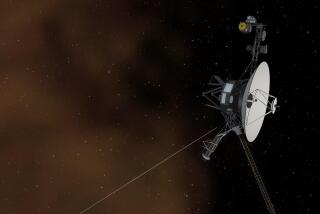Shuttle Starts Experiments, Surveys Gilbert Damage
KENNEDY SPACE CENTER, Fla. — The crew of the first post-Challenger flight turned the shuttle Discovery into an orbital laboratory today and later surveyed Mexico for damage from Hurricane Gilbert.
“You guys made an awful lot of people very, very happy here on Earth yesterday,” Mission Control told Discovery’s five-man crew in a morning teleprinter message beamed up to the shuttle.
“Judging from the headlines, a lot of people around the world are also happy for our success yesterday. It sure is great to have Americans back in orbit.”
Mexico Damage Surveyed
The astronauts--commander Frederick H. Hauck, 47, co-pilot Richard O. Covey, 42, John (Mike) Lounge, 42, David C. Hilmers, 38, and George D. (Pinky) Nelson, 38--took time today to survey Mexico for damage from Hurricane Gilbert.
“Houston, we’re coming over the eastern coast of Mexico right now, trying to get some pictures to see if we can see any damage that was done by that hurricane that missed us,” Covey said during the ship’s 16th orbit.
At mid-morning, NASA ships pulled into Port Canaveral, south of the Florida space center, with Discovery’s two solid-fueled rocket booster casings in tow. The boosters underwent major redesign after a flawed O-ring seal triggered the Challenger accident, killing its seven astronauts on Jan. 28, 1986.
The Discovery crew was awakened about 5:37 a.m. by a taped message from comedian Robin Williams provided by a Houston radio station, NASA said.
“Goooood morning Discovery!” Williams said, adapting a line from his movie “Good Morning, Vietnam.” “Rise and shine, boys, time to start doing that shuttle shuffle. You know what I mean? Hey! Here’s a little song coming from the billions of us to the five of you. Rick, start ‘em off baby, the Hauckster, to you!”
The astronauts then were entertained by the theme song from the television series “Green Acres,” with suitably modified lyrics. Hauck thanked Mission Control and the crew got to work, facing a light schedule for the remainder of their four-day flight before landing Monday at 9:33 a.m. PDT at Edwards Air Force Base, Calif.
Experiments Activated
Nelson activated two experiments early today--one to obtain ultra-pure protein samples in the weightlessness of space with a technique called “isoelectric focusing” and the other to find out if low gravity can help produce lighter, stronger metals.
Nelson said both devices appeared to be working properly, along with a 3M materials science machine. Another experiment to study the behavior of red blood cells had completed its initial runs.
One minor problem that developed Thursday aboard the shuttle was a frozen cooling system. To thaw it out, the ship’s big radiator panels in the cargo bay were allowed to run warmer than normal and cabin temperature soared to 88 degrees at one point.
The astronauts were told to drink more water to avoid becoming dehydrated, but they said they were comfortable.
More to Read
Sign up for Essential California
The most important California stories and recommendations in your inbox every morning.
You may occasionally receive promotional content from the Los Angeles Times.










